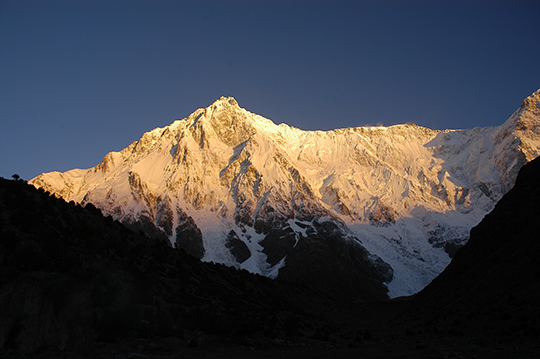
[Photo] Martinez de la Varga/Shutterstock.com
3:37 p.m., February 26, Pakistan–Simone Moro (Italy), Muhammad Ali Sadpara (Pakistan) and Alex Txikon (Spain) reached the summit of Nanga Parbat, the thirteenth 8000-meter peak to get a winter ascent. The successful climb leaves K2 as the only 8000-meter peak that has not been climbed in winter.
Nanga Parbat, the ninth highest mountain in the world, is located in the western Himalaya, in Gilgit-Baltistan, Pakistan. German climber Hermann Buhl completed the first ascent of the peak, by the East Ridge–reaching the summit alone and without the use of supplemental oxygen–in 1953.
[Read about previous winter attempts on Nanga Parbat here Climbing Nanga Parbat in the Cold Winter Months and here Avalanche Ends Season of Winter Attempts on Nanga Parbat and here Winter Thwarts Poles on Nanga Parbat–Ed.]
International Teams Unite
Members of two separate teams came together to form the final summit team. A total of three teams started up the peak, but one had retreated after fixing lines and hauling loads between camps. Txikon and Sadpara, along with Daniele Nardi of Italy, arrived at Base Camp (4000m) on Nanga Parbat’s Diamir (west) Face on December 31. With a second team of climbers–Adam Bielecki and Jacek Czech of Poland–they spent nearly a month fixing ropes and hauling gear to Camps 2 and 3 on the Kinshofer Route (ca. 3500m, Kinshofer-Low-Manhardt, 1962), which follows a buttress left of the Diamir Face.
While hauling gear between Camp 1 (4800m) and Camp 2 (6100m), at about 5800 meters, Bielecki fell about 80 meters, wrote Valentina D’ Angella on danielenardi.org. While not seriously injured, Bielecki and Czech opted to abandon the climb. After several rotations on the route from Base Camp to Camp 3, Nardi also chose to descend.
Raheel Adnan’s website Altitude Pakistan followed the progress of a third team–composed of Moro and fellow Italian Tamara Lunger–that began on the Messner-Eisendle route. After encountering unsafe conditions, they descended to join Txikon and Sadpara on the Kinshofer Route.
Before Moro and Lunger joined their group, Txikon and Sadpara had several false starts from Base Camp in January, and they had turned back because of avalanche conditions, including one slide that partially buried the climbers on January 29, wrote Igone Mariezkurrena on the website alextxikon.com. Throughout February, the four climbers took turns climbing the start of the Kinshofer Route to maintain the track, but were unable to continue beyond Camp 1 because of high winds.
On February 22, they took advantage of a weather window, climbing the fixed route to Camp 2 the first day. Three days later, on February 25, they made it to Camp 4 (7200m), Mariezkurrena said. Lunger, who became ill, started with the team the next morning, but abandoned her bid a few hundred meters below the summit, Adnan said.
A timeline on Altitude Pakistan’s History of Winter Climbing Nanga Parbat details thirty-one known winter attempts on the peak, from the 1988-89 winter season through the 2014-15 season. Six teams attempted Nanga Parbat during the 2015-16 season, including the Polish-Pakistani team on the Schell Route (ca. 4500m, Gimpel-Schauer-Schell-Sturm, 1976) on the Rupal (south) Face; and the “Nanga Light Expedition” on the northeast side, between the Diamir (west) and Rakhiot (north) flanks.
Winter Ascent Guidelines
Back in the 1970s, winter Himalayan ascents were often defined as those that took place during the original Nepali winter permit season from December 1 through the end of February. During the twenty-first century, the definition has shifted to calendar winter between December 21 and March 20, the winter solstice and spring equinox, respectively.
The winter season adds extreme cold temperatures, high winds and unstable terrain, beyond the usual severe conditions encountered on 8000-meter peaks. Winter attempts on Nanga Parbat and K2 have been especially difficult. Adding to the challenge, the two peaks have 4608 and 4020 meters of prominence, respectively, more than any other mountains in the western Himalaya.
“Six teams attempted Nanga Parbat this winter,” Adnan told us in an email. “Two on Rupal side and four on Diamir. Apart from the three mentioned teams, [the] summit push of Tomek Mackiewicz and Elisabeth Revol ended at 7500m due to extreme cold in January. They were on Messner-Eisendle route.”
Records
This climb marks Moro’s fourth time reaching the summit of an 8000-meter peak in winter, states Altitude Pakistan. Simone Moro now has twelve successful summits on nine 8000-meter peaks, including four ascents of Mt. Everest (8848m). Alex Txikon has completed thirteen summits on eleven 8000-meter peaks. Muhammad Ali Sadpara, a mountaineer from the Skardu village of Sadpara, in Pakistan, has completed six ascents of four 8000-meter peaks, including three summits of Nanga Parbat (8125m).
“Climbing any giant in the winter, especially that one shows incredible respect, discipline and courage,” Vince Anderson said, who established a 4100-meter route on Nanga Parbat’s Rupal Face in September 2005, with Steve House. “They definitely deserve all the accolades they receive for this. It’s a huge feat: Out there in the winter, in a true wilderness, on a massive mountain in difficult and dangerous conditions.”
This story was updated on March 1 at 9:23 a.m.–Ed.